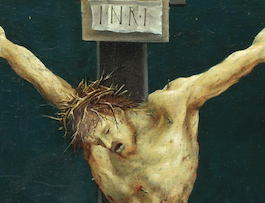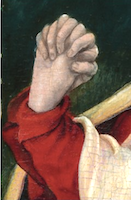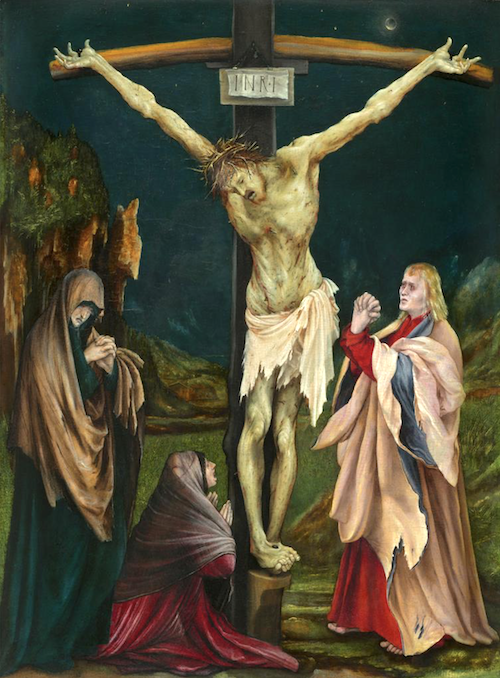The Small Crucifixion
- JEM SULLIVAN
As the canvas bends outward this sacred scene moves into our space.
 The Small Crucifixion
The Small Crucifixion by Matthias Grünewald
(c. 1475/1480-1528)
Jesus' Passion was an unequaled suffering. The Son of God incarnate, whose divinity surpasses and embraces all humanity, offered himself as a sacrifice for all. No one, not even the saintliest person, can take on the sins of all or offer himself as a sacrifice for humanity as a whole. Only God can and did.
It is this gift and mystery of faith, at the heart of the Lenten journey, that Matthias Grünewald, master German painter, brings to life in his vivid, visual homily titled The Small Crucifixion. This early 16th-century masterpiece invites reflection not only on the historical event of the Lord's crucifixion, but on the redemptive meaning of Christ's suffering love, poured out for all and for each of us. For Grünewald's image invites the viewer to walk the Via Crucis, the path of Jesus' Paschal journey from Good Friday to Easter Sunday.
Obedient to death on the cross
Only some twenty-two paintings of Matthias Grünewald survive to the present day. The Small Crucifixion, from the permanent collection at the National Gallery of Art, Washington, D.C., is among those extant works. His best known masterpiece is the Isenheim Altarpiece, commissioned for the high altar of the church of the Monastery of Saint Anthony in Alsace, where patients suffering from the plague and various skin diseases were treated. In that large altarpiece, Grünewald depicts a crucified Christ whose body is scourged with plague-type sores. Patients bearing the pain of their physical afflictions found spiritual comfort as they gazed on the crucified Jesus and identified with the mystery of his suffering. The Small Crucifixion was, most likely, a personal devotional image, intended either for a domestic setting or a private chapel.
He was wounded for our transgressions
 In The Small Crucifixion, the artist draws the viewer into the horror of Jesus' Passion. Every artistic element — color, line, form, and composition — conveys with remarkable expressive power the depths of Jesus' abandonment, his deep desolation, and the extreme physical suffering of a crucifixion. His emaciated body is racked with scars of torture. His gaunt face and bowed head evoke his unbearable agony. Under a piercing crown of thorns, our Lord's sacred face bleeds. His tattered loincloth gives evidence of the depravity of his tormentors. Few artists have conveyed the scene of the crucifixion with the intense realism that Grünewald brings to his composition.
In The Small Crucifixion, the artist draws the viewer into the horror of Jesus' Passion. Every artistic element — color, line, form, and composition — conveys with remarkable expressive power the depths of Jesus' abandonment, his deep desolation, and the extreme physical suffering of a crucifixion. His emaciated body is racked with scars of torture. His gaunt face and bowed head evoke his unbearable agony. Under a piercing crown of thorns, our Lord's sacred face bleeds. His tattered loincloth gives evidence of the depravity of his tormentors. Few artists have conveyed the scene of the crucifixion with the intense realism that Grünewald brings to his composition.
The artist sets the scene of the crucifixion in a scant landscape, painted in an unusual greenish blue color. The dark backdrop is a reminder of the Gospel detail that the sun darkened and all of creation itself groaned at the hour of Jesus' passing from this world. A visitor who has the opportunity to stand in front of this painting in its museum setting cannot help but notice that the small panel bends outward into the viewers' space. Few can remain passive bystanders or objective onlookers in the face of Grünewald's emotionally gripping masterpiece.
From the center radiate the Lord's outstretched arms on the cross. His twisted hands and contorted feet rivet and hold the eye. For his sacred hands and feet convey the inexpressible divine anguish over human alienation from God. The humility of the Son of God, who was obedient even to death on a cross, rises to his Father as a perfect oblation through his gnarled, knotted fingers that strain up to the heavens. His ankles, twisting beneath the brute force of the nail that pierces his feet, evoke the chains of the world's sinfulness. The crossbeam strains downward not only under the mass of his wounded body but from the full weight of divine mercy that takes the form of crucified love.
By his stripes we are healed
On either side of the cross stand Mary, the Virgin Mother of God, and the Beloved Disciple and Evangelist, Saint John. Mary's robed head is bowed, her hands clenched in prayer, evoking her unique share in her Son's suffering. John's tightly clasped hands convey the agony of this faithful disciple of the Lord. Kneeling in anguished meditation at the foot of the cross is Saint Mary Magdalene. All three figures enter intensely into the Lord's Passion, as they witness his trial, condemnation, agony, and death. Their perspective is meant to be ours as we contemplate this Gospel moment.
As the canvas bends outward this sacred scene moves into our space. The stark realism of Grünewald's depiction allows little room for one to remain a mere spectator. The force of self-emptying love compels our participation in this sacred mystery. With eyes of faith we begin to recognize that the poverty of incarnate divine love is poured out abundantly for all humanity. Grünewald's imagination lets us see God's relentless mercy take the form of suffering love. Through an artist's eye, we are invited to recognize and to receive the gift of crucified love that reconciles us to God.

By your holy cross you have redeemed the world
The good news of Good Friday is that death no longer has the final word on the human condition. To enter into the mystery of Jesus' Passion and Death on the cross is to be filled with hope in the victorious power of God who will raise his Son from the dead. As we journey from Good Friday to Easter Sunday, Grünewald's image evokes the vocation of every Christian to live the new life of the risen Christ. For we know and believe in faith that the horror of Jesus' crucifixion will most certainly give way to the radiant glory of his, and our own, Resurrection. This gives us confidence to pray, "We adore you, O Christ, and we bless you, because by your holy cross you have redeemed the world."
 This is Meaghen Gonzalez, Editor of CERC. I hope you appreciated this piece. We curate these articles especially for believers like you.
This is Meaghen Gonzalez, Editor of CERC. I hope you appreciated this piece. We curate these articles especially for believers like you.
Please show your appreciation by making a $3 donation. CERC is entirely reader supported.

Acknowledgement
 Jem Sullivan. "The Small Crucifixion." Magnificat (April, 2019).
Jem Sullivan. "The Small Crucifixion." Magnificat (April, 2019).
Reprinted with permission of Magnificat.
Courtesy National Gallery of Art, Washington.
The Author
 Jem Sullivan is on the Pontifical Faculty of the Immaculate Conception at the Dominican House of Studies in Washington D.C. She teaches courses on Catholic Education: Teaching and Learning, the Documents of Vatican II, and Christian Art and the New Evangelization. She is the author of Study Guide to the United States Catholic Catechism for Adults and The Beauty of Faith.
Jem Sullivan is on the Pontifical Faculty of the Immaculate Conception at the Dominican House of Studies in Washington D.C. She teaches courses on Catholic Education: Teaching and Learning, the Documents of Vatican II, and Christian Art and the New Evangelization. She is the author of Study Guide to the United States Catholic Catechism for Adults and The Beauty of Faith.




